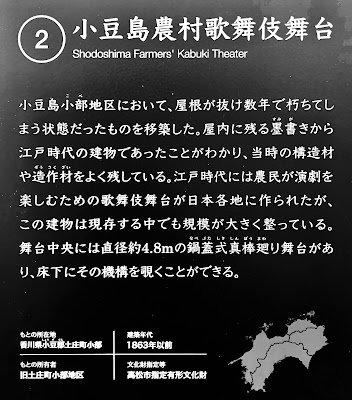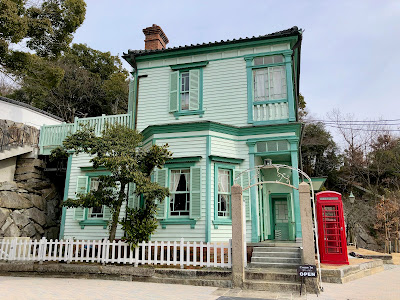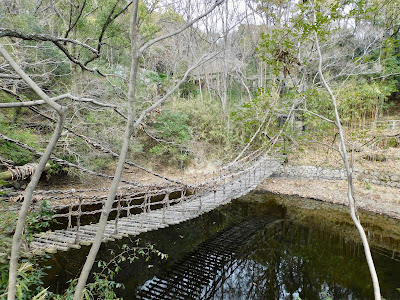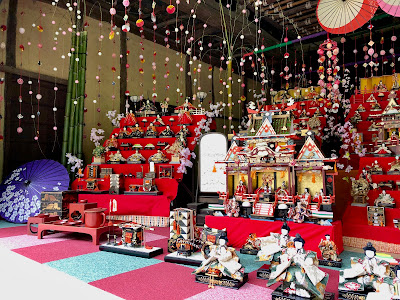 |
| 結婚10周年アートの旅 2023年2月6-12日 2月14日が私達の結婚記念日、私と夫Rは "結婚10周年アートの旅" をしました。 このセクションは主に四国村 (シコクムラ) ; ㊺㊻①②⑤についてです。 10th Wedding Anniversary Art Trip, 6th of February 6th -12th of February 2023 February 14th was our wedding anniversary, and my husband R and I had a "10th wedding anniversary art trip". This section is mainly about Shikoku Mura ; ; ㊺㊻①②⑤. |
目次 / Contents
1) 入り口付近 / Around Entrance
A. 入り口 / Entrance
B. 流れ坂 / Nagare-zaka Hill
C. ㊻四国村カフェ / Shikoku Mura Cafe
2) ①かずら橋 / Vine Bridge
3) ②小豆島農村歌舞伎舞台
Shodoshima Farmers Kabuki Theater
4) ⑤山下家住宅 / Yamashita Family House
 |
| 四国村マップ 約 51,000 m²の敷地 広大な敷地です。 初日の観光地は、ここに1本に絞りました。 Shikoku Mura Map Site of approximately 51,000 m² It's a vast site. I decided to narrow it down to just one sightseeing spot on the first day. 画像は下記より / This From below ★ |
1) 入り口付近 / Around Entrance
A. 入り口 / Entrance
四国村は、四国四県から江戸時代から明治時代の民家を中心とする、33棟の建物を移築復元した野外博物館です。
公式サイト : ★
1976年(昭和51年)に開館しました。
私もRも家を見ることが好きです。
英国でも、機会があれば、野外博物館に行きます。
Entrance
B. 流れ坂 / Nagare-zaka Hill
Shikoku Mura is an open-air architectural museum that has relocated and restored 33 buildings, mainly private homes from the Edo to Meiji periods, from the four prefectures of Shikoku.
Official website: ★ only in Japanese
It opened in 1976.
Both R and I like looking at houses.
In the UK, we also go to open air museums when we have the chance.
 |
| ㊺おやねさん は、入場チケット販売所であり、 ミュージアムショップでもあります。 ㊻四国村カフェ / ①かずら橋 ②小豆島農村歌舞伎舞台 ㊺Oyanesan is the ticket sales booth and also the museum shop. ㊻Shikokumura Cafe / ① Kazura Bashi : Vine Bridge ②Shodoshima Farmers' Kabuki Theater |
 |
| パンフレット表 四国村ヒストリー→★ Cover of Leaflet in Japanese Shikoku Mura History →★ in English  パンフレット裏 Back of Leaflet in Japanese and English |
 |
| "Nagare-zaka Hill, 1976" by a sculptor, Masayuki Nagare (1923 -2018) Material : "Aji-stone" "Aji-stone" : ★ is a fine-grained granite that shines more the more it is polished. I am impressed that a hill can also become a work of art. .jpeg) 作 : 流 政之 (ナガレマサユキ/ 1923 -2018) 庵治石 (アジイシ : ★ / ★) は、磨くほどに輝きを増す、 キメが細かい花崗岩(カコウガン)です。 坂も作品になり得ることに、感動します。 .jpeg) |
'流れ坂' は、マップ⑦'石畳広場'まで続いています。
The 'Nagare-zaka Hill' continues to Map ⑦ 'Stone Pavement Square'.
C. ㊻四国村カフェ / Shikoku Mura Cafe
 |
流れ坂からのカフェ Cafe from the Nagare-zaka |
2) ①かずら橋 / Vine Bridge
 |
①かずら橋へ向かう石段 Stone Steps Leading to ① Kazura Bashi : Vine Bridge |
Ksazura means Actinidia Arguta, the Hardy Kiwi or Kiwiberry in Japanese.
This is one of the vine plants.
"Vine Bridge : Kazura-bashi" is a suspension bridge made from woven vine : Kazura.
The Japanese name for the shirakuchi-kazura plant is sarunashi (monkey pear), so named because monkeys eat its fruit.
Even today, 'Kazura-bashi' bridges are still in use in real nature.
The 'Kazura-bashi' in Miyoshi City, Tokushima Prefecture, is 45m long, 2m wide and 14m high above the valley.
It is one of the 'Three Unusual Bridges of Japan' and an Important Tangible Folk Cultural Property.
However, for safety reasons, wire is used in this bridge.
I believe the Kazura-bashi in Shikoku Mura has also been reinforced with modern features.
The Kazura-bashi in Shikoku Mura is two-thirds the size of the one in Miyoshi City.
 |
①かずら橋 / Vine Bridge 私は吊り橋が苦手なので、渡りませんでした。 Rは嬉しそうに渡っていました。 I'm not good with suspension bridges, so I didn't cross it. R looked happy to cross it.  |
Shodoshima Farmers Kabuki Theater
According to Shikoku Mura Website about ⑤Yamashita Family House,
 |
| 床下のまわり舞台はここで見ることができます。→★ |
According to Wiki about Shōdoshima,
"Shōdoshima or Shōdo Island is an island located in the Inland Sea of Japan. The name means 'Island of Small Beans'."
 |
Before 1863 (late Edo period) You can see the revolving stage under the floor here. →★ only in Japanese 横から / From Side |
 |
| 観客席 / Spectator Seats |
 |
| 観客席の上から From Top of Spectator Seats |
 |
| 豪華なお雛様がたくさん Many Gorgeous Hina-dolls |
毎年、ここでは、2月から3月に、期間限定で、お雛様が飾られます。
お雛様は、主に、香川県の一般家庭からの寄贈品だそうです。
その中には、'御殿飾り'と呼ばれる貴重なものもあります。
下記、'ふらここ' サイトより引用。
Every year, from February to March, Hina dolls are displayed : Hina-matsuri here for a limited time.
The Hina dolls : a set of ornamental dolls are mainly donated by ordinary households in Kagawa Prefecture.
Among them are some precious ones called 'Gotenkazari'.
According to website 'Furacoco about 'Gotenkazari' only in Japanese,
(translated by me)
"Gotenkazari is a Hina doll decoration that imitates the Shinden (palace where the emperor lived) of Kyoto in the Heian period (794 - 1185).
Gotenkazari were made from the late Edo period (1603 - 1868) to the Showa period (1925 - 1989), and was particularly popular in the Kansai region, especially Kyoto, during the Meiji era (1868 - 1912) and Taisho period (1912 - 1926).
(In the Kanto region at that time, 'dan-kazari (platforms display)' was the mainstream.)
The style of Gotenkazari is to arrange the Dairibina (male and female dolls) imitating the emperor and empress in a 'Goten', which is modeled after the imperial palace of Kyoto, and to display dolls such as court ladies, servants, and attendants (Minister of the Right and Minister of the Left).
It has an atmosphere like a modern dollhouse, and the glamorous life of the aristocrats is depicted in detail like a diorama. "
こんな豪華なお雛様を見ることができて、私達はラッキーでした。
We were so lucky to be able to see such a gorgeous display.
4) ⑤山下家住宅 / Yamashita Family House
 |
| ⑤山下家住宅 外観の正面の写真がありません。 ⑤Yamashita Family House I don't have a photograph of the front exterior. Late 1700s (late Edo period)  |
"This old farmhouse was once in the eastern end of Kagawa Prefecture near the Tokushima border.
It is a relatively small house, only about 8.8 meters wide and 5 meters deep. This kind of small farmhouse is known as a gururi hachiken in that valley. “Gururi” refers to the outside perimeter of the house, while “hachi” is 8 and “ken” is a traditional measure equal to around 1.8 meters.
So, it’s a small house that’s only about 118 meters around.
It has a rustic layout with one room with earthen floored area and raised wooden floor, and a bedroom in the back, making it a typical example of farmhouses in the Higashi-sanuki region."
 |
山下家住宅 / Yamashita Family House 画像は下記より / These from below ★ |
 |
| 天井 天井と呼ぶよりも、屋根と呼ぶべきでしょうか? Ceiling Should we call it a roof rather than a ceiling? |
 |
| 土間 Doma : Doma Earthen–floored Space |
According to Shikoku Mura Website about ⑤Yamashita Family House,
"The doma earthen-floored work area takes about half of the space, and was used to hull rice or grind barley in a foot-powered mortar."
 |
脱穀機?/ Thresher? 唐箕 (トウミ) かも? Might be for Winnowing? |
下記、Wikiより
"唐箕(とうみ)とは、臼などで籾殻 (モミガラ) をはずしたあと、
風力を起こして穀物を 籾殻・玄米・塵などに選別するための農具。"
According to Japanese Wiki about Toumi ; winnowing or winnowing machine,
(translated by me)
"A winnowing machine is a farm tool used to generate wind power to separate grains into chaff, brown rice, dust, etc. after removing the chaff with a mortar or other tool."
 |
唐箕中 / Winnowing 江戸時代 (1603 - 1868) の唐箕 Winnowing in Edo Period (1603 - 1868) 画像は下記より / These from below |
次のセクションも四国村についてです。
The next section is also about Shikoku Mura.






















0 件のコメント:
コメントを投稿